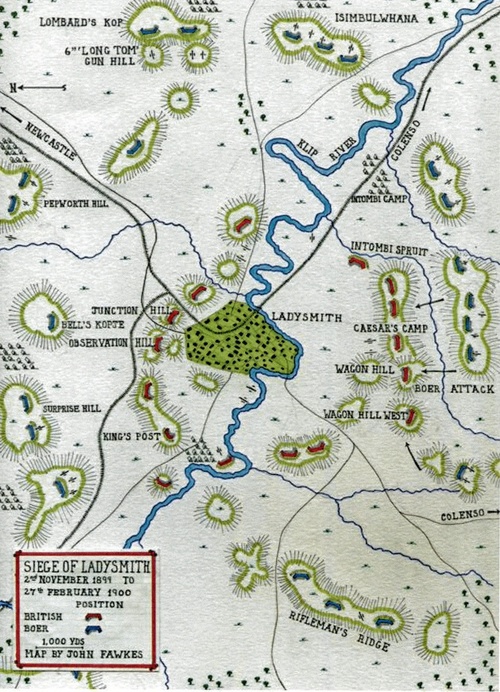Auction: 20001 - Orders, Decorations and Medals - conducted behind closed doors
Lot: 155
The Queen's South Africa Medal awarded to Private W. J. Leo, Rifle Brigade, who was severely wounded when a member of the raiding party which destroyed a 'troublesome' enemy artillery piece in the dead of night on Surprise Hill
Queen's South Africa 1899-1902, 2 clasps, Defence of Ladysmith, Laing's Nek (6020 Pte. W. J. Leo. Rifle Brigade), minor edge nicks, very fine
William J. Leo was severely wounded on the night of 10/11 December 1899 at Surprise Hill whilst serving with the 2nd Battalion, Rifle Brigade. Departing Ladysmith at 10pm, 500 men of the Battalion climbed the 600ft high square-topped kopje Surprise Hill undiscovered, which enabled Lieutenant Robert J. T. Digby-Jones, V.C., of the Royal Engineers, to destroy a 4.7-inch howitzer with gun-cotton:
'For weeks past it had been one of the most troublesome guns of the thirty-two that surround us. It had a long range and accurate aim. Its position commanded Observation Hill, part of the Newcastle Road, Cove Hill and Leicester Post, the whole of the old camp and all the line of the country away to Range Post and beyond. It was this gun that shelled the 18th Hussars out of their camp and continually harassed the Irish Fusiliers. It was constantly dropping shells into the 69th Battery and on the King's Royal Rifles at King's Post.' (The Capture of Surprise Hill, refers)
Having 'blown the breech clear out' and destroyed the screw, the order was given to retire and the line began to climb down in the darkness. As they descended, the British were met by the Pretoria Kommando, the young Deneys Reitz among its ranks. In the darkness it became increasingly difficult to differentiate friend from foe and the British resorted to fighting their way with the bayonet:
'The only way was to stoop down till you saw the edge of a broad-brimmed hat. Then you drove your bayonet through the man, if he did not shoot your first. Many a poor fellow was shot down by some invisible figure who was talking to him in English and was taken for a friend.'
Despite bayonetting their way through the Boer ranks and inflicting considerable losses, the British were subject to a ferocious and sustained enemy assault, and lost approximately 12 killed and 44 wounded, with a further six men trusted to the care of those left on the hillside being captured as the sun began to rise. By 3.30am the battle was over and the survivors slowly made their way to Leicester Post, all the while harried by Boer sniping, particularly towards the medical units.
A cairn to the memory of the Riflemen killed in action was later constructed at the base of the hill and affixed with a plaque. The gallant Lieutenant Digby-Jones was killed in action not long thereafter on 6 January 1900 when struck in the throat by a bullet. He was buried in Ladysmith Cemetery and a second cairn was erected on neighbouring Waggon Hill at the spot where he died.
Subject to 20% VAT on Buyer’s Premium. For more information please view Terms and Conditions for Buyers.
Sold for
£270
Starting price
£100







